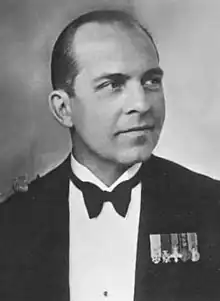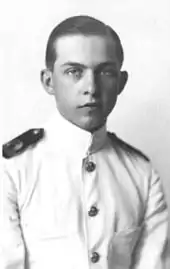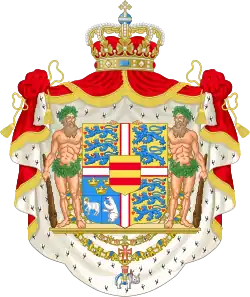Paul of Greece
Paul (Greek: Παύλος, Pávlos; 14 December 1901 – 6 March 1964) was King of Greece from 1 April 1947 until his death in 1964. He was succeeded by his son, Constantine II.
| Paul | |
|---|---|
 Paul in 1939 | |
| King of the Hellenes | |
| Reign | 1 April 1947 – 6 March 1964 |
| Predecessor | George II |
| Successor | Constantine II |
| Prime Ministers | See list
|
| Born | 14 December 1901 Tatoi Palace, Athens, Greece |
| Died | 6 March 1964 (aged 62) Athens, Greece |
| Burial | 12 March 1964 Royal Cemetery, Tatoi Palace, Greece |
| Spouse | |
| Issue | |
| House | Glücksburg |
| Father | Constantine I of Greece |
| Mother | Sophia of Prussia |
| Signature |  |
Paul was first cousin to Prince Philip, Duke of Edinburgh and father-in-law to Juan Carlos I of Spain.
Early life

Paul was born on 14 December 1901 at the Tatoi Palace in Attica north of Athens, the third son of King Constantine I of Greece and his wife, Princess Sophia of Prussia. He trained as an army officer at the Royal Military College, Sandhurst and later at the Hellenic Military Academy in Kypseli, Athens. Paul was an army officer cadet in the Coldstream Guards and Lieutenant with the Evzones. To his family, he was known as Palo.[1]
From 1917 to 1920, Paul lived in exile with his father, Constantine I. From 1923 to 1935, he lived in exile again in England, this time with his brother, George II. He worked briefly in an aircraft factory under an alias, and through Viscount Tredegar met and befriended notorious literary muse Denham Fouts, who later alleged an affair.[2], claiming they had themselves identically tattooed with a small blue insignia above the heart.[3][4] A friend of Fouts, John B. L. Goodwin said Fouts often made up stories about his life,[5] and literary critic Katherine Bucknell thought many of the tales about him were myths.[6] Henry Channon wrote in his diary that Paul was a bisexual rake before his marriage.[7]
Marriage and children

On 9 January 1938, Paul married Princess Frederica of Hanover, his first cousin once removed through Frederick III, German Emperor, and Victoria, Princess Royal, and second cousin through Christian IX of Denmark, in Athens. They had three children:
- Sophia, Queen of Spain (born 1938)
- Constantine II, King of the Hellenes (1940–2023)
- Irene (born 1942)
World War II
During most of World War II, from 1941 to 1946, when Greece was under German occupation, Paul was with the Greek government-in-exile in London and Cairo. From Cairo, he broadcast messages to the Greek people.
Reign
Paul returned to Greece in 1946. He succeeded to the throne in 1947, upon the death of his childless elder brother, King George II, during the Greek Civil War (between Greek Communists and the non-communist Greek government). In 1947 he was unable to attend the wedding of his first cousin, Prince Philip, Duke of Edinburgh to the future Queen Elizabeth II of the United Kingdom as he was suffering from typhoid fever.[8]
By 1949 the Civil War was effectively over, with the Communist insurgents ceasing the majority of their operations, and the task of rebuilding the shattered north of the country began.[9]
In the 1950s Greece recovered economically, and diplomatic and trade links were strengthened by Paul’s state visits abroad. He became the first Greek Monarch to visit a Turkish Head of State. However, links with Britain became strained over Cyprus, where the majority Greek population favored union with Greece, which Britain, as the colonial power, would not endorse. Eventually, Cyprus became an independent state in 1960.[10]
In order to promote the then barely developed tourism on the Greek islands, Paul and Friederike invited all ruling and former ruling European royal families to a cruise between the islands in 1954, for which the shipowner Pétros Nomikós made his passenger ship Agamemnon available. Over 100 guests took part in this 14-day voyage, which became known as the “Cruise of the Kings” and was repeated in 1956 on the ship Achilles between Athens and Corfu.[11] Albrecht, Duke of Bavaria, and his family took part in these trips, which is why he decided to return to Paul the Greek crown jewels of the Wittelsbach king Otto of Greece, who had been deposed in 1862. Albrecht's son Prince Max presented these to Paul in December 1959. It had been almost a century since they were last in Greece.
Meanwhile, republican sentiment was growing in Greece. Both Paul and Frederica attracted criticism for their interference in politics,[12] frequent foreign travels, and the cost of maintaining the Royal Family. Paul responded by economising and donated his private estate at Polidendri to the State.[13]
In 1959, he had an operation for a cataract, and in 1963 an emergency operation for appendicitis. In late February 1964, he underwent a further operation for stomach cancer, and about a week later on 6 March 1964, King Paul I died in Athens.[14] He was succeeded by his son, Constantine II.
Foreign honours
 United Kingdom:
United Kingdom:
- Honorary Knight Grand Cross Royal Victorian Order - 1937
- Honorary Admiral Royal Navy - Feb 1953[15]
- Stranger Knight Companion of the Order of the Garter - 1963
Legacy
In March 2014, a memorial service took place in the grounds of Tatoi Palace in Athens commemorating the fiftieth anniversary of Paul's death. Members of the Greek and Spanish royal families were present.[16][17]
Ancestry
Notes and sources
- The Duke: Portrait of Prince Philip. Written by Tim Heald
- Vanderbilt, p. 30; Wishart, p. 52
- Vanderbilt, Arthur (2014). Riverdale Avenue Books (ed.). Best-Kept Boy in the World. New York. p. 112. ISBN 978-1936833-41-2.
{{cite book}}: CS1 maint: location missing publisher (link) - Capote, Answered Prayers, p. 5.
- Clarke, p. 172
- Bucknell, p. 941
- Simon Heffer (ed.), Henry 'Chips' Channon: The Diaries 1938-43, Penguin, London 2022, fn429.
- Van der Kiste, p. 177
- Van der Kiste, p. 179
- Van der Kiste, p. 180
- Francis of Bavaria (with Marita Krauss): Zuschauer in der ersten Reihe: Erinnerungen (Front row audience: memories), publisher C. H. Beck, 2023, p. 128−132. According to his memory, all European royal dynasties, who considered themselves a large family, except the British royal family, took part in this cruise. See also: Cruise of the Kings and photo:
- Clogg, p. 153; Woodhouse, p. 283
- Van der Kiste, pp. 182–183
- Van der Kiste, pp. 183–184
- "Page 972 | Supplement 39779, 13 February 1953 | London Gazette | the Gazette".
- "GRC: Greece and Spanish Royal Families Attend Commemorative Mass For King Paul I of Greece Pictures & News Photos | Getty Images". gettyimages.co.uk. Retrieved 4 September 2015.
- "Spanish and Greek royals come together in Athens to remember King Paul I of Greece". Hello Magazine. 6 March 2014.
- Bricka, Carl Frederik (ed.). "Louise". Dansk Biografisk Leksikon. Vol. 5. p. 593.
- Chisholm, Hugh, ed. (1911). . Encyclopædia Britannica. Vol. 11 (11th ed.). Cambridge University Press.
- "Olga Constantinovna (1851–1926)". Women in World History: A Biographical Encyclopedia. Gale Research. 2002.
- Meisner, Heinrich Otto (1961), "Friedrich III", Neue Deutsche Biographie (in German), vol. 5, Berlin: Duncker & Humblot, pp. 487–489; (full text online)
- Louda, Jiří; Maclagan, Michael (1999), Lines of Succession: Heraldry of the Royal Families of Europe, London: Little, Brown, p. 34, ISBN 978-1-85605-469-0
References
- Bucknell, Katherine (1996). Christopher Isherwood Diaries: Volume One 1939–1960 London: Methuen. ISBN 0-413-69680-4
- Clarke, Gerald (1988). Capote: A Biography. London: Hamish Hamilton. ISBN 0-241-12549-9
- Clogg, Richard (1992). A Concise History of Greece, Cambridge University Press
- Vanderbilt, Arthur (2014). Best-Kept Boy in the World: The Life and Loves of Denny Fouts. Magnus Books
- Van der Kiste, John (1994). Kings of the Hellenes. Stroud, Gloucestershire: Alan Sutton Publishing. ISBN 0-7509-0525-5
- Wishart, Michael (1977). High Diver. Blond and Briggs
- Woodhouse, C.M. (1998). Modern Greece: A Short History, Mackays of Chatham, Kent
- Μιχάλης Φύλλας, «Στιγμές από την ιστορία της σύγχρονης Ελληνικής θεολογίας. Ο βασιλιάς Παύλος και η «Ένωση Ελλήνων Θεολόγων», Σύναξη, τχ.156, (Οκτώβριος-Δεκέμβριος 2020), σελ.85-88.
.svg.png.webp)
.svg.png.webp)
